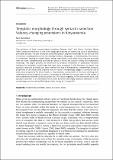Templatic morphology through syntactic selection: Valency-changing extensions in Kinyarwanda
Author(s)
Banerjee, Neil
Download920-15822-1-PB.pdf (6.736Mb)
Terms of use
Metadata
Show full item recordAbstract
The existence of both morphological templates (Hyman 2003) and Mirror Principle (Baker 1985) compliant behaviour in the same language presents an interesting case of grammatical principles at odds. The two principles sometimes predict opposite orderings for the surface form of valency-changing derivational morphology in Bantu languages. In Kinyarwanda, this tension is unresolved, leading to certain forms being unavailable, rather than favouring one principle over the other. Independently available periphrastic forms are used to convey the problematic meanings. This paper presents an alternative to syntactic movement or Optimality Theoretic analyses for templatic morphology that have been proposed in the literature. It argues that syntactic selection by heads can better derive the facts of Kinyarwanda. Independent syntactic properties of the heads that underlie the derivational morphology suggest a particular set of selectional properties for these heads in Kinyarwanda, independent of the data showing their ordering. An analysis based on syntactic selection is sufficient to account both for the orders of the morphemes and their syntactic properties. This result suggests, in line with recent work, that syntactic selection is an alternative mechanism by which seemingly templatic behaviour in the morphology can be realised (Pylkkänen 2008; Harley 2013; Jung 2014). Keyword: Morphology; Template; Syntax; Selection; Bantu
Date issued
2019-09Department
Massachusetts Institute of Technology. Department of Linguistics and PhilosophyJournal
Glossa
Publisher
Ubiquity Press, Ltd.
Citation
Banerjee, Neil. 2019. Templatic morphology through syntactic selection: Valency-changing extensions in Kinyarwanda. Glossa: a journal of general linguistics 4(1): 112. 1–31. © 2019 The Author(s)
Version: Final published version
ISSN
2397-1835